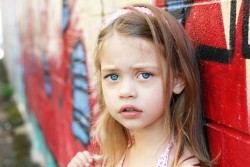 Anxiety is a typical part of growing up – in fact, it’s a normal human reaction to stress. For most kids, feelings of anxiety, fear and shyness come and go and, like most developmental phases, lessen and disappear over time. But for some children, anxiety becomes excessive, overwhelming — or even debilitating.
Anxiety is a typical part of growing up – in fact, it’s a normal human reaction to stress. For most kids, feelings of anxiety, fear and shyness come and go and, like most developmental phases, lessen and disappear over time. But for some children, anxiety becomes excessive, overwhelming — or even debilitating.
The number of children suffering from anxiety disorders is larger than you might think. According to the National Institutes of Mental Health, more than 25% of children will experience an anxiety disorder in their lifetime. Further, almost 6% of 13- to 18-year-olds experience severe anxiety disorders.
Given how common anxiety is, how do parents know if their child experiences too much or an unusual amount of it? An understanding of the different types of anxiety, and the signs and symptoms associated with each, can help you determine whether your child’s anxiety is part of a typical developmental stage — or a problem that warrants concern and may require more specialized help.
Anxiety and Development
 Most people experience anxiety when facing stressful situations – and this isn’t necessarily a bad thing. Though it may seem counterintuitive, anxiety actually provides some benefits.
Most people experience anxiety when facing stressful situations – and this isn’t necessarily a bad thing. Though it may seem counterintuitive, anxiety actually provides some benefits.
Think of it this way: As the St. Louis Medical Behavioral Institute describes it, anxiety serves as the body’s natural alarm system, an evolutionary adaptation that’s there to warn you that may be in a dangerous situation.
Of course, in today’s world, the “dangers” we face aren’t quite the same as those of our ancestors — but our bodies and minds react in much the same way! So, while you might be feeling anxious about an upcoming public speaking engagement rather than, say, worrying about running into a saber tooth tiger, you’ll probably experience similar symptoms, from feeling jittery, to muscle tension, to a rapid heartbeat.
Children also experience anxious feelings in reaction to stressful situations. According to the American Academy of Child and Adolescent Psychiatry, starting at about 8 months of age, most infants begin to experience intense feelings of distress and anxiety whenever they’re separated from their parents or caregivers. At this age, such feelings are simply a part of typical development.
Typical fears change as children age and reach new developmental stages. Keeping in mind that every child develops at a different rate, Harvard Medical School lists these other, “normal,” age-appropriate sources of fear and anxiety:
- Newborns: Fear of loud noises and falling
- From 6 months: Fear of strangers
- From 8 months: Fear of separation from parents
- Preschool age children: Fear of the dark, masks, large animals, insects, supernatural creatures
- School-age children: Death of family members, failure at school, events on the news such as kidnappings, terrorist attacks, wars, natural disasters
- Adolescents: Concern about the future of the world, social and sexual anxieties
Parents may need to take action if these fears and anxieties last beyond the typical age-appropriate boundaries or become so pronounced that they:
- Interfere with daily life
- Disrupt family harmony
- Inhibit social relations
- Interfere with school success
- Cause serious distress
What is an Anxiety Disorder?
 If anxiety has a negative affect on your child’s daily life, they may be one of the 40 million Americans that suffers from an anxiety disorder. Anxiety disorders last for six months or longer, according to the National Institutes of Mental Health, and may get worse if they’re not effectively treated.
If anxiety has a negative affect on your child’s daily life, they may be one of the 40 million Americans that suffers from an anxiety disorder. Anxiety disorders last for six months or longer, according to the National Institutes of Mental Health, and may get worse if they’re not effectively treated.
There are several types of childhood anxiety disorders, including:
- Separation Anxiety
- Generalized Anxiety Disorder or GAD
- Social Anxiety Disorder or Social Phobia
- Panic Disorder
- Post-Traumatic Stress Disorder or PTSD
- Specific Phobias
Each childhood anxiety disorder has its own symptoms, signs, and treatment options, though some may overlap.
Separation Anxiety
As many as 41% of children experience some form of separation anxiety in their lives. Of these, from 5 to 10% meet the criteria for separation anxiety disorder, making it the most common childhood anxiety disorder, according to research by E. Jane Costello.
Though almost all children experience separation anxiety in some form or another from infancy until the preschool years, fearful feelings generally hit their peak between 18 months and 3 years of age, according to the Anxiety and Depression Association of America.
Separation anxiety is characterized by feelings of worry or fear that begin when a caregiver goes out of sight or leaves the room. Children attending preschool or daycare for the first time may also get upset when their caregiver leaves.
However, children with separation anxiety disorder tend to worry excessively, feeling strong fear and anxiety when they’re away from their parent or caregiver. They tend to imagine that horrible things will happen if they’re apart and, unlike “typical” kids, they’re not easily consoled. If your child is older than 7 years and still experiencing severe separation anxiety, it could be an anxiety disorder.
Symptoms of separation anxiety disorder may include:
- Inability to sleep alone
- Being excessively “clingy”
- Panicking or throwing tantrums when caregivers try to leave
- Extreme homesickness
- Feelings of misery when away from their caregiver
- Refusing to go to school, sleepovers or camp
- Stomachaches or other vague physical complaints
- Nightmares or trouble sleeping
- Constant, intense worry about the caregiver’s well-being
Fortunately, there are several ways to help your child overcome separation anxiety. The Mental Health Foundation suggests:
- Exposing your child to a wide range of experiences and people, including other children, outside of the home
- Allowing your child to make their own decisions as much as possible so they can gain self-confidence
- Helping your child to fall asleep on their own, at night and at nap-time, by establishing a set routine
- Ensure that they spend some time away from home and caregivers before starting school or daycare
- Modeling self-care behaviors: Don’t act anxious or worried around your child; instead, show them ways to relax by demonstrating them and setting an example
Generalized Anxiety Disorder or GAD
 Kids with generalized anxiety disorder or GAD experience consistent, exaggerated worry and tension, even when there’s no reason to expect anything will go wrong.
Kids with generalized anxiety disorder or GAD experience consistent, exaggerated worry and tension, even when there’s no reason to expect anything will go wrong.
Those suffering from GAD are always afraid that the worst is going to happen, seeing disaster around every corner. While adults with GAD may worry about issues like money and health, children with GAD may worry about the safety of family members, about school performance, about getting hurt, and about stuff like crimes, storms and even the family car running out of gas, according to Harvard Medical School.
In addition, kids with GAD tend to need constant reassurance and seek approval from adults. They may also be concerned with meeting others’ expectations, show self-doubt, and be self-conscious. If your child experiences any of those and the following symptoms for 6 months of more, they may be suffering from GAD:
- Excessive worry that’s not grounded in reality
- Trouble falling or staying asleep
- Restlessness and agitation
- Muscle tension
- Headaches, stomachaches and other vague physical complaints
- Fatigue
- Easily startled
- Trembling and twitching
- Irritability
- Nausea and gastrointestinal discomfort
According to the National Institutes for Mental Health, about 3.1% of the population has GAD. Genetics plays a role in the disorder; a child is more likely to have GAD if a parent has it.
Cognitive behavioral therapy – or CBT — may ease the symptoms of GAD. Parents can facilitate CBT at home by:
- Modeling self-confident behavior
- Helping children learn to solve problems on their own
- Offering rewards when children overcome their fears
You can also practice relaxation techniques with your child, such as deep breathing and progressive muscle relaxation exercises.
Deep-breathing exercises are especially helpful, as they can be done unobtrusively during stressful situations, such as a test at school. Have your child practice several times a day by:
- Focusing solely on their breathing, closing eyes if possible
- While breathing through the nose, place one hand on the belly
- Notice an expanding, rising motion with every intake of breath, and a falling motion with every exhale
- Count up while inhaling and count down while exhaling
- Visualize filling body with clean, fresh air and expelling stale air
- Continue focusing on the rising and falling motion
Progressive muscle relaxation can also be practiced at school or in other stressful situations. Have your child practice this exercise several times per day by:
- Sitting with feet resting comfortably on the floor
- Tensing toes by curling them into the soles of the feet
- Holding for a few seconds before relaxing
- Stretching out the legs and tensing them; hold for a few seconds, then relax
- Moving upward tense, then relax the rest of the body, including stomach, chest, arms, hands, shoulders, neck and face
- Finishing by tensing the entire body, then relaxing
- Sitting quieting and noticing which parts of the body feel stress; re-tense and relax these parts
Younger children may respond well to adding an imaginative element to these exercises, such as “pretend you’re squeezing the juice from an orange when you tense your hands” or “imagine you’re squishing your toes into a mud puddle,” according to the Center for School Mental Health Analysis and Action.
Though these techniques are helpful during times of stress, having your child practice them regularly when they’re not feeling extremely anxious will help them become second nature.
Social Anxiety Disorder or Social Phobia
 Social anxiety disorder, also known as social phobia, is much more than just shyness. Kids with social anxiety disorder tend to feel excessively self-conscious and fearful in social situations. Often, they believe that they’re constantly being judged or watched and live in constant fear of embarrassing themselves.
Social anxiety disorder, also known as social phobia, is much more than just shyness. Kids with social anxiety disorder tend to feel excessively self-conscious and fearful in social situations. Often, they believe that they’re constantly being judged or watched and live in constant fear of embarrassing themselves.
Situations such as getting called on in class, reading aloud, going to parties, or having to talk to teachers or peers may cause overwhelming anxiety; kids suffering from social phobia may worry about upcoming social situations for days or weeks at a time. These fears can be absolutely debilitating, causing kids to dread school and other activities, and making it very hard to make or keep friends.
Symptoms of social anxiety disorder may include:
- Clinging to parents or other adults
- Freezing or hiding
- Excessive fear of strangers, both children and adults
- Avoidance of social situations
- Fear of meeting people or talking to people
- Few friends
- Tantrums or crying
- Selective mutism, or refusal to speak
- Stomachaches, “butterflies” or queasiness
- Rapid heartbeat
- Shortness of breath
- Dizziness
- Blushing
About 15 million Americans suffer from social phobia, according to the Anxiety and Depression Association of America, with a typical onset age of 13 years. Not surprisingly, social anxiety disorder can lead to feelings of loneliness, isolation, low self-esteem, depression and risk of low academic success.
Parents can help reduce their child’s social anxiety by:
- Teaching social skills
- Encouraging – and facilitating – children to make friends by arranging play dates
- Limiting screen time and other solitary activities
- Teach deep-breathing and progressive muscle relaxation exercises for use in stressful situations
- Encourage your child to rate their fear on a scale of 1 to 10, with 10 being the worst fear imaginable; when children can compare fear ratings and see that, say, a ‘3’ fear isn’t that bad, it may help them to better deal with anxiety and stress
Parents can also help by teaching their child to challenge, and eventually replace, negative thoughts. Often, those suffering from social anxiety are overcome by negative thoughts, such as “I’m going to look stupid,” or No one likes me.” Such thoughts often come up automatically, so it’s essential to help your child recognize such thoughts for what they are: Irrational.
When you hear your child speaking negative sentiments aloud, counter them with realistic positive statements. For instance, if they say, “I’m going to mess it up,” counter with, “You don’t know that. Last time you tried, you did really well.” Teach your child to identify such negative thoughts, evaluate and rate them, and replace them with positive ones.
Panic Disorder
 A panic attack can be very scary, for both the child experiencing it and their parents. During panic attacks, which come on suddenly with no apparent trigger, children may experience a range of symptoms, including:
A panic attack can be very scary, for both the child experiencing it and their parents. During panic attacks, which come on suddenly with no apparent trigger, children may experience a range of symptoms, including:
- Overwhelming feelings of impending doom or dread
- Chest pain
- Shortness of breath
- Trembling
- Nausea
- Dizziness
- Racing heart or palpitations
After an attack, children often worry about having another one, leading to fears of losing control or going crazy. This, in turn, can lead to avoiding places or situations where an attack may occur and, in extreme cases, agoraphobia.
If your child has suffered more than two panic attacks, followed by at least one month of worry about more attacks, they may be experiencing a panic disorder. About 6 million Americans experience panic disorder, according to the Anxiety and Depression Association of America.
Though panic disorder is often treated with psychotherapy or CBT, parents can help their child deal with panic disorder by practicing calming techniques and talking with them about worries. Help your child manage symptoms by:
- Educating yourself about the disorder; this will help you to understand how your child is feeling
- Listen to your child when they speak about how they feel without offering advice or judgment
- Stay calm during an attack; you can’t really intervene to stop most attacks, so provide your child with a composed, calm presence
- Gently remind your child that they made it through the last attack
- Though panic attacks are unpredictable, be mindful of transition points, such as going to school, that may trigger the behavior
- Praise any improvements or efforts, even if it’s just a small step
- Teach your child deep-breathing and muscle relaxation techniques
Post-Traumatic Stress Disorder or PTSD
 For children who’ve experienced or witnessed a traumatic event, post-traumatic stress disorder or PTSD can cause lasting feelings of anxiety.
For children who’ve experienced or witnessed a traumatic event, post-traumatic stress disorder or PTSD can cause lasting feelings of anxiety.
PTSD can be caused by a number of situations, such as natural disasters, accidents, abuse or neglect. According to Harvard Medical School, PTSD symptoms tend to manifest in three ways:
- Re-experiencing
- Avoidance
- Arousal
When a child displays re-experiencing symptoms, they may suffer from flashbacks, nightmares or painful memories about the trauma. In some cases, children feel compelled to reenact traumatic events through play. Many also feel extreme anxiety when exposed to anything that reminds them of the trauma.
Avoidance symptoms include the need to stay away from any places, people, feelings, dates, or thoughts that are associated with the traumatic event. Over time, this may lead to feelings of emotional numbness, detachment from others, and a tendency toward isolation.
Arousal symptoms may include irritability, sleep problems, jumpiness, and trouble concentrating.
Symptoms must last for a month or more for a diagnoses of PTSD. The National Institutes of Mental Health estimate that 7.7 million Americans suffer from PTSD.
If your child is diagnosed with PTSD, you can help manage the disorder by:
- Being a supportive, active listener
- Remind the child that what happened was not their fault
- Try to keep to normal, structured routines
- Practice calming breathing and muscle relaxation techniques
- Encourage your child to gradually face the fearful situation
- Schedule pleasant activities and events with your child’s input
- Acknowledge and reward progress
Dealing with anxiety and its accompanying disorders presents a challenge for children and parents alike. By acting as a soothing and supportive presence, practicing active listening skills, modeling healthy behavior, and teaching problem-solving skills, you can help your child deal with those worrisome feelings.
If your child is struggling with anxiety or fear, be sure to take a look at The Anxiety-Free Child Program and start helping your child live the childhood they deserve with simple and affordable resources you can start using in your own home TODAY.
Click Here to Help Your Anxious Child
Sources:
- http://www.nimh.nih.gov/statistics/1ANYANX_child.shtml
- http://www.theglobeandmail.com/life/parenting/young-children/behaviour/the-two-questions-all-parents-of-young-kids-should-ask-themselves/article2416009/
- http://www.slbmi.com/child_adolescent/childhood_anxiety.htm
- http://etd.lsu.edu
- http://www.health.harvard.edu/newsweek/Childrens_fears_and_anxieties.htm
- http://www.hawaii.edu
- http://www.adaa.org/living-with-anxiety/children
- http://aacap.org/cs/root/facts_for_families/the_anxious_child
- http://www.fdu.edu/newspubs/magazine/09ws/anxiety.html
- http://www.anxietybc.com
- http://www.schoolmentalhealth.org/Resources/Clin/QuickGuide.pdf
- http://www.helpguide.org/mental/social_anxiety_support_symptom_causes_treatment.htm
- http://www2.massgeneral.org/schoolpsychiatry/info_panicdisorder.asp#interventions_home
- Photo Credits: John_Wilkinson,Anas Bukhash (nascity), Tony Webster





